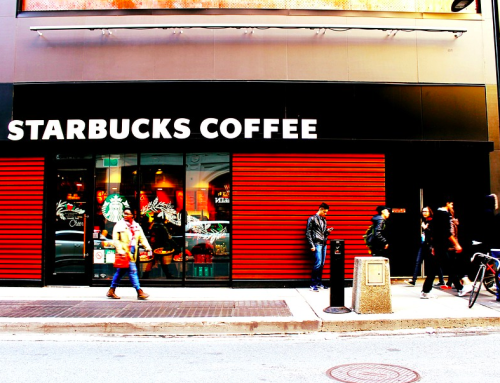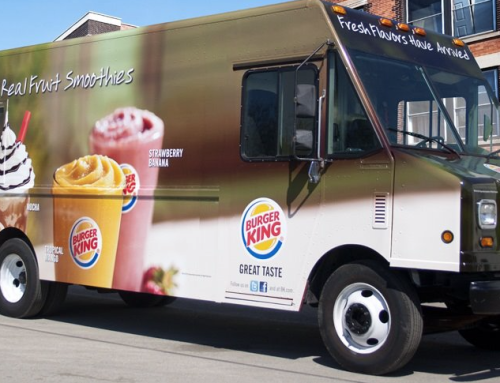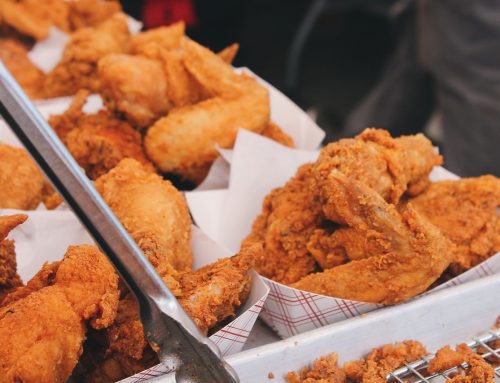Outback Steakhouse is an iconic chain is known for its hearty steaks, delicious ribs, and Aussie-inspired fare. But before you pull out your wallet, personal savings and invest in this franchise, it’s important to do your due diligence and perform a SWOT analysis on the restaurant.
In this article, I take a closer look at the Strengths, Weaknesses, Opportunities, and Threats of Outback Steakhouse. While this chain had a tough run from 2007 – 2010, the company kept hope and the concept returned to growth over the past decade. Read on to learn more about this popular restaurant chain and if the business is poised to survive and thrive the next 10 years.
Understanding the SWOT Analysis
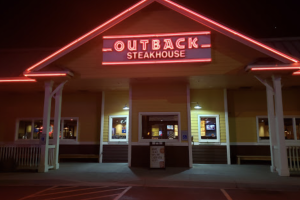
Outback Steakhouse lit up at night.
The four key elements of the SWOT analysis are strengths, weaknesses, opportunities and threats. This is a powerful tool business strategists use to better understand the health of a business.
- Strengths can be used to create niche positioning in a market while striving for lessening or removing these same
- Weaknesses expose vulnerabilities about a business. Ideally after you find a weakness, you should also try to find a solution that at the very least mitigates the risk.
- Opportunities section spells out where you could see growth for the company.
- Threats are areas of concern for the business. These are specific things or events that could reduce the companies earnings or put the company out of business all together.
Strengths
Adaptive menu. Outback Steakhouse has a successful record of launching new products and catering to different markets based on local consumers. One recent example is adding gingerbread flavored food and drink items with help from Jeremiah’s Italian Ice. Outback Steakhouse will need to continue to innovate with their menu to keep customers intrigued.
Deep investment coffers. Outback Steakhouse was purchased in 2007 by Bain Capital, an investment firm with a reported $160 billion in total assets based out of Boston. This means Outback Steakhouse, if needed, has a lot of money they can tap into if needed to expand or change strategy. The fact is money buys you time to adapt and tweak a business model until you identify a strategy that works.
Related Reading: Dunkin’ Donuts SWOT Analysis: The Hidden Weakness
Ability to increase menu prices. Outback Steakhouse’s parent company Bloomin’ Brands has been able to raise menu prices in recent years. This ability to increase prices helps curb the impacts of inflationary prices. In 2020, the restaurant was able to increase menu prices by 3% and saved $100 million as a result. Later the company decided they needed to raise prices by 5% to curb even higher expenses.
Growing in Brazil. The Outback Steakhouse brand resonates in the country of Brazil. If you’re familiar with the Brazilian steakhouse concept, you might not be surprised that the restaurant has gained a following within the country. Average restaurant unit sales volumes raised to $35,182 in April, 2021 in Brazil. This was in spite of most of the sales remaining off-premises during this time period.

Dining room in an Outback Steakhouse.
Focus on waste reduction. Outback Steakhouse’s parent company Bloomin’ Brands has been busy taking all sorts of actions toward reducing the amount of food and water waste to improve profitability and preserve natural resources. The parent company reports saving 52 million gallons of water as a result of installing more efficient dish washing machines. Training is also provided to team members so they understand how to reduce energy waste between shifts.
Continued headwinds in the United States. More people want to get out there and experience life again. More consumers are feeling comfortable returning to sit-down dining. This is an overall positive trend for the restaurant industry as a whole as the company has a chance to capitalize on pent-up demand.
Bloomin’ Brands is growing. Grow in same-store sales units is surpassing pre-pandemic levels. Unit sales were up 12.1% in June 2021 compared to June, 2019 levels. This demonstrates a positive outlook for casual dining brands.
Weaknesses
Lack on The company has a strong history of innovation, but they haven’t focused on it as much in the past few years.
They are not built for delivery. Some concepts like McDonald’s, Dominoes, and Starbucks thrived at the start of the pandemic. But Outback Steakhouse was built with on-site dining in mind. The company has been able to shift a respectable volume of sales with off-premises dining. But some meals like steak dinners are just right after they’re pulled out of the oven or off a flat top.
Outback needs to implement technology into its frontend and backend processes. One way the company is attempting to adapt is through the Outback Steakhouse app. This app allows customers to make orders and earn reward points through a loyalty program. The app also allows you to schedule curbside pickup or delivery.

Famous Bloomin Onion at Outback Steakhouse.
Easily to replicate. It is easy for Outback’s business model to be replicated. In fact, it has been replicated by many competitors already. The competition includes Texas Roadhouse, Longhorn Steakhouse, Ruth’s Chris Steakhouse, and Black Angus Steakhouse among others. Still, Outback Steakhouse remains the most popular with an impressive 706 units.
Lower advertising. Bloomin’ Brands says they plan to reduce advertising spend. While this is great for the bottom line, it might not be the best longterm strategy. In this day and age, you can’t just be a one-trick pony. You have to keep up with all of the trends or risk being left behind in what seems like an instant society. Investing in marketing is one way to remain top of mind with consumers.
The ROI and profitability of this concept must remain steady. Bloomin’ Brands delivered a strong return on investment of more than 14% in 2021. But previous years weren’t great for the company as the company delivered a negative return in 2020. The company will need to maintain more consistent revenues and profitability coming out of the health crisis.
Opportunities
Outback needs to work closely with politicians and lobby groups. The restaurant will want to focus on entering more democratic markets that promote free will of citizens. Where freedom is more restricted, it hasn’t faired well for this restaurant chain as the lock-downs in 2020 showed.
Outback must improve their AI and data collection. This will empower the company to make predictions on consumer demand and cater to subsets of their customer base.
Related Reading: SWOT Analysis for Red Bull: The Overlooked Threat of this Energy Drink
Outback Steakhouse is in prime position to tap into lucrative opportunities overseas. Countries like the United Kingdom, United Arab Emirates, and South America represent global expansion opportunities for the chain that’s already proven itself in Brazil.
Outback has the opportunity to explore adjacent markets in entrepreneurial finance, marketing and mergers & acquisitions. The company has deep ties with private equity should be utilizing these creative opportunities.
Threats
Outback Steakhouse should be cautious about the pressure from protesters and non-governmental organizations. As crazy as it seems, we could eventually be limits on the amount of meat intake an individual can eat due to environmental restrictions. As environmental pressures from global governments increase the entire meat concept is at risk.
Outback Steakhouse has eyed China for its next phase of growth. But there is a growing tension between US China trade relations could lead to protectionism, more friction into international trade, rising costs both in terms of labor cost and cost of doing business in this country.
Labor shortage. It’s no secret that there’s a labor shortage among restaurant staff including cooks, waiters / waitresses, dish washers and management. With a shortage of talent to run the business, the company may need to pay higher wages to keep up with inflation. This will cut into profitability.
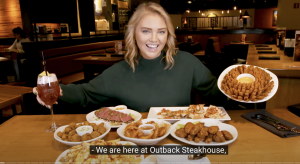
Inside Outback Steakhouse.
Global inflation and recession. According to this report in Fortune Magazine, we have a 35% probability of heading into a recession. If this happens, we can expect to see consumers with less discretionary income to spend on eating out or retail.
Related Reading: Costco SWOT Analysis: Will Supply Chain Woes Impact Profit?
Supply chain issues and food shortages. Overall food prices are expected to increase another 4.5% – 5.5% this year. There are supply chain issues and food shortages being triggered by the unfortunate events in the Ukraine. Bottom line, it feels like restaurants of all sizes will be dealing with supply chain problems at some level for the next 1 – 2 years.
Whether you’re an Outback Steakhouse potential investor or evaluating franchise options, it’s important to do your research before making a “buy” decision. I hope this SWOT analysis has given you food for thought at the very least. Don’t forget to sign up for our email list so you can stay up-to-date with all the case studies (including revenue numbers) we publish each week.

